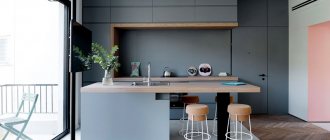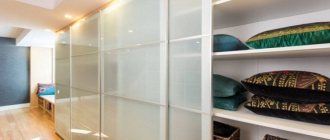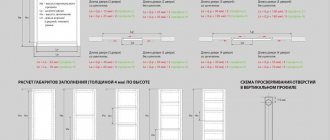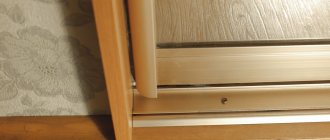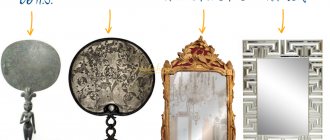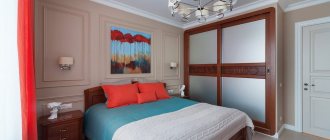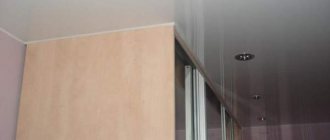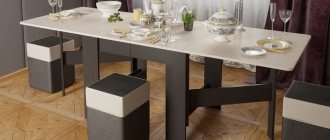Standard cabinet sizes
Standard cabinet sizes.
The dimensions of any cabinet are measured in three planes - height, width, depth, and are indicated in millimeters; the cabinet does not have such a size as length. The standard dimensions of the simplest cabinet are height 2100, width 1300, depth 600 millimeters. But if this answer does not suit you, let's look at each cabinet size separately. In this article we will talk about the standards for hinged cabinets for residential premises; we will talk about sliding wardrobes next time.
Cabinet depth.
The depth of the cabinet is determined by the size of what is planned to be stored in it. For outerwear, dresses, and other clothes, the storage of which involves the use of hangers, the depth of the closet should be 550 - 600 millimeters. In all other cases, its depth can be reduced to 400 - 500 millimeters. An exception may also be cabinet models in which the hanger bar is located perpendicular to the facade.
Cabinet width.
The width of the cabinet depends on the number of doors; the standard dimensions for each door are 400 - 450 millimeters, but in practice you can most often find cabinet doors with a width of 430 mm. Accordingly, the standard width for a cabinet with one door will be 430 millimeters, for a two-door cabinet 860 millimeters, for a three-door cabinet 1300 millimeters, etc.
Cabinet height.
The standard cabinet height is from 2100 to 2400 millimeters. This height of the cabinet is determined by its contents. The main “devourer” of closet space is the space for storing clothes using hangers; the recommended height of such a compartment is 1450 millimeters, and the height of the hanger bar from the floor should be 1900 millimeters; these closet dimensions are determined based on human ergonomics. All remaining space is filled with various shelves, drawers and mezzanines and, in fact, only its upper part can affect the height of the cabinet.
Calculation of the width of cabinet doors.
Calculation of the dimensions of cabinet doors is carried out according to the same rules as for furniture facades, namely, when cutting blanks from chipboard for overhead cabinet doors (installed in the vestibule), it is necessary to take into account the thickness of the edge with which we will line the ends and 3 millimeters for the gap with the adjacent door . Examples:
- For a cabinet 2100 by 430 millimeters, the size of the door blank should be 2098 by 428 millimeters. (subtract 1 mm for the PVC edge on each side)
- For a cabinet 2100 by 860 millimeters, the size of the blank for each door should be 2098 by 425 millimeters. (subtract 1 mm for the PVC edge on each side plus 3 mm for the gap with the adjacent door)
When making furniture with your own hands and calculating the dimensions of inset cabinet doors (into the opening), deviate from the dimensions of the opening by three millimeters on each side.
Wardrobe: photos, dimensions, diagrams, filling options, shelves
A sliding wardrobe is a profitable and stylish interior solution for a small apartment. Thanks to the sliding system and optimal placement of shelves and compartments, it holds a large number of things and saves living space. The door components move on special rollers. This allows you to freely use the space in front of the cabinet as you wish. The basis of this type of furniture is chipboard, the color scheme of which has no boundaries.
As for the design, it all depends on the flight of your imagination. The design can be various ornaments and designs. For a child’s room, it could be a favorite cartoon character or animal.
It’s hard to imagine a hallway or bedroom without a built-in wardrobe. This multifunctional piece of furniture fits harmoniously into any interior and also helps to visually increase the room space.
Depending on the type of construction, they can be of different sizes, and the “filling” of the cabinet can also be different. Often, you and the carpenter decide which shelves you want to put inside and how much free space to leave for clothes on hangers.
Standard dimensions of a built-in wardrobe:
• height – 245 cm, • length at the top – 275 cm, • length at the bottom – 240 cm, • width of the shelves inside – 80 cm, • height of the inner wall – 163 cm.
You can complete and change the dimensions of the internal shelves at your discretion. Most often, a bookcase for books is adjacent to the side of the wardrobe. The wardrobe is closed with large sliding mirrors (usually with a pattern) and has lighting from above.
Types of sliding wardrobes according to design:
- Straight - the doors in it are located in the same plane. Several cabinets are installed at a certain angle or connected using a corner structure. The last option is relevant for a corner wardrobe.
Radius - in this type, the sliding system has a curved shape. It can be asymmetrical, curved, round.
Built-in - no side or back surface. We can say that they have slightly more useful volume than other types of furniture. Due to the fact that there are no bulky elements, the most original design solutions will be appropriate.
- Cabinet - represent a single ensemble in which all the walls, floor, and ceiling are present. The main advantage of this type is that it can be easily moved from place to place.
What should be the dimensions of built-in wardrobes?
To get furniture that will fully meet your wishes, you need to clearly carry out all the necessary procedures. We present you some tips on creating the ideal model of a future piece of furniture:
1. Of course, the dimensions of the built-in wardrobe depend on correctly taken measurements of the room . We take careful measurements of the height, length and width of the room in which the cabinet will be placed. Uneven walls, baseboards, baguettes, etc. should also not be forgotten and taken into account when calculating. It also depends on the location whether you can dispense with the back wall or the top cover. This will help you save some money on your furniture purchase.
When calculating dimensions, measurements are made of the length, width and height of the room, and such nuances as the door frame, light switch, radiator, window and other objects that will be located at the installation site of the cabinet or next to it are also taken into account. First, the overall dimensions are determined. Let's say we want to place our future wardrobe in the bedroom, at the entrance near the door, the width of which from the wall to the door frame is 1600 mm, and the height from floor to ceiling is 2600 mm.
Don’t rush to make a closet of exactly the same size right away!!
Pay attention to baseboards and baguettes (mostly everyone has them), as well as to uneven walls, which can also occur. Subtract from the overall dimensions, width and height, gaps for baguettes, baseboards and unevenness (usually 50-100). Only after this can the overall dimensions be determined. As for its total depth, it is basically standard - 600, the useful area in depth will be 500 mm, because 100 will be needed to install the sliding system. If it is not possible to make a standard cabinet depth, you can, of course, reduce it, but we do not recommend making it less than 400. In this case, it will no longer be possible to install a regular pipe for hangers (the width of things on hangers needs at least 500), you will need to install special retractable system for clothes. Standard sizes of sliding wardrobes
2. When making calculations, first of all, decide for yourself what purposes this furniture will be used for . For example, if you plan to place books in it, then you should provide a transparent door. Clothes, underwear, etc. It is better to store it behind a matte or completely invisible sliding system.
3. Let us designate the internal dimensions of the sliding wardrobes . The desired depth is 600 mm, of which 100 will go to the door system for the sliding wardrobe. It is not recommended to reduce the first number below 400. Do not forget that in this case the hanger pipe, trouser holder, tie holder will no longer fit, because they require at least 500 mm.
4. There are no standard parameters for sliding wardrobes, as they are manufactured according to individual wishes . However, there are certain recommendations for dimensions, following which you will get excellent furniture.
The width indicator directly depends on the duration of the guide along which the doors will move. On average it is 4-5 meters. The minimum indicator for this characteristic is 1 meter. If it is less, the structure will be extremely unstable. The height is limited by the long chipboard slab (average - 278 cm), which we will also talk about in subsequent paragraphs. To “add” height to the cabinet, mezzanines with separate guides and doors are built on top.
5. What should be the dimensions of a sliding wardrobe door ? This indicator again depends on the overall width of the product and what it will be filled with. They should not interfere with unobstructed access to drawers and other sections. For example, if the height of the finished furniture reaches 2500 mm, then the width of the door system should be from 700 mm, but not more than 1000 mm. We must not forget that the wider the lower rollers, the higher the stability will be. At the same time, the sliding system itself will move much more smoothly.
6. The chipboard, which is the main component of the cabinet frame, has several basic sizes. This is also worth taking into account and finding out in the store in advance which one is in stock. It may be that to achieve the length or width you require, craftsmen will have to connect several pieces of material. In this case, it is necessary to hide all the connecting points as much as possible.
7. The choice of design for external panels depends on the overall interior of the house and the specific room. Today, manufacturers offer customers to independently design the color and design of the future piece of furniture. Modern online stores offer their customers options for filling sliding wardrobes with detailed dimensions and photos. In addition, with the help of special services and ready-made measurements, you can calculate the estimated cost of the finished product.
Examples of filling sliding wardrobes
Using a visual diagram where you can see the filling of a sliding wardrobe, you can see examples of combining different components. Of course, they are all conditional; select the best ideas for yourself and create something of your own.
Making your own cabinet
Work begins with determining the installation location of the structure and taking dimensions. After this, a drawing of the cabinet is drawn up, indicating its dimensions and contents. This can be done simply by hand. The main thing is to establish the dimensions, the number of sections, their purpose, and then decide on the content. But today it is possible to create a higher-quality drawing using special software.
Modern computer programs allow you to automate the process as much as possible
Important! When taking dimensions, due to the unevenness of the floors, the indicators at different heights may vary (it is recommended to measure the width of the opening at three points inside it and at three points outside). In this case, it is necessary to focus on a smaller value, otherwise the cabinet will not be able to fit into the opening.
Assembly of a standard sliding wardrobe, main stages of work
First, you should measure the opening into which the structure will be installed. In our case, its length is 3000 mm.
First, measurements are taken
Now you need to draw a sketch of the structure. The cabinet will have 3 doors, 1 m wide and 4 internal sections:
- for long items - 600 mm;
- shelves (two compartments of 400 mm each);
- for short clothes - 950 mm;
- for ironing board + roll-out drawers (150 mm under the board and 500 mm under the section with drawers).
The two outer doors will overlap two sections (one completely and one partially). As a result of the filling layout, the following diagram was obtained.
Scheme of a standard wardrobe
According to this scheme, you can order the production of parts externally or produce them yourself. Naturally, when calculating elements it is necessary to take into account the thickness of the material.
Assembly stages.
- Installation of the cabinet should begin with one of the side sections. In our case, a part with roll-out drawers and a compartment for an ironing board. Reinforcements are installed for structural rigidity. The shelves are fixed. The fastening points are closed with decorative plugs. The assembled section is still being installed in its place, but is not secured to the wall.
Installing shelves
The assembled section is still being installed in its place
- The section from the other edge is assembled in a similar way.
Assembling a section from the other edge - The middle sections are being assembled. A small nuance - if shelves in adjacent compartments are installed at different levels, the parts that are located below are mounted first.
- The mezzanine is installed and attached to the sections.
Installation of mezzanine - The cabinet is fixed to the wall.
- The internal filling of the cabinet is installed.
Drawer installedInstallation of telescopic guides
- The hanger bars are secured in the center of the partitions.
- The side panels are installed, followed by the top and bottom panels. These panels are made from 25 mm thick laminated chipboard covered with a 2 mm thick PVC edge.
- The top guide is fixed.
Fixing the top guide - The bottom rail is secured with double-sided adhesive tape.
- Sliding doors are installed.
Installation of sliding doors - The valves are being adjusted.
The doors are mainly responsible for the appearance of the cabinet. Even inexpensive designs can be very attractive. In our example, doors made of laminated chipboard in the shade of mountain larch with colored glass trim are installed, which harmonizes perfectly with the interior of the room.
This is what the assembled wardrobe looks like
Making a simple cabinet from chipboard with your own hands
The proposed cabinet model is made of white chipboard (with PVC-lined edges). The back wall and bottom are missing. The peculiarity of this design is that the ceiling covering is a tension fabric , therefore, to install the upper guide, a chipboard corner fixed on the sides is used. This will not affect the reliability of the system, since the load-bearing part in this product is the bottom rail, which bears the main load. The upper guide only supports the sash in the desired plane.
White chipboard
The cabinet is equipped with two doors trimmed with mirrors. The aluminum sliding system ADS is used as guides, which is characterized by smooth and quiet operation. The size of each door is 230 x 118 cm. Telescopic guides are used for drawers.
Step 1. A cabinet diagram is drawn up.
Scheme of the future cabinet
It is also necessary to draw up a specification of the necessary parts. In our case it looks like this:
- racks - 4 pcs.;
- boxes - 3 pcs.;
- corner blanks - 2 pcs.;
- shelves - 12 pcs.;
- rods - 2 pcs.;
- doors - 2 pcs.
Step 2. Markings for fasteners are applied to the chipboard slabs. For these purposes, it is more convenient to use a special template.
Marking on chipboards
Holes are drilled in the cabinet jumpers. A total of 4 such racks are needed.
Drilling holes
Holes are also created at the ends of the walls and shelves.
Holes are created at the ends of elements
Step 3. Boxes are assembled. The frame of the retractable products is attached using self-tapping screws.
Assembling the drawer frame
Prices for the range of impact drills
Impact drill
The bottom is fixed. You need 3 of these boxes.
After this the bottom is attached
Guides are fixed to the sidewalls. Guides for moving drawers are also installed on two racks.
Installation of guides
Step 4. Assemble the base for the top rail. The guide will be fixed to a chipboard corner.
Chipboard corner
Step 5. The hanger rods are sawn off according to size.
The rods are cut to size
The cut needs to be sanded.
Prices for popular models of eccentric sanders
Random orbital sander
Step 6. Installation of the structure. In order to assemble the cabinet, it is important to clear the area, including the baseboards.
Skirting boards were dismantled in the right place
The two outer sections are assembled.
Assembling the outer sections
Clothing rods are attached. The corner to which the upper guide is fixed is fixed. Roll-out boxes are installed.
The rod and the top guide are fixed
The bottom rail is fixed. The sashes are hung.
Our cabinet is ready for use
Making such a simple design will not take more than one day. The great advantage of the product is its availability - the cost of the materials and accessories used will not cause much damage to the family budget.
Sizes of wardrobe for clothes
When there is a desire to buy or order a wardrobe, questions arise related to what dimensions the future furniture should have.
These are not idle questions, since they are directly related to the convenience and ergonomic performance of future furniture. Therefore, let’s consider what are the standard sizes of sliding wardrobes and what variations are permissible.
The information will help you navigate general issues related to the size of the wardrobe.
Standard wardrobe depth
Let's start with the depth of future furniture. This parameter has two values:
If the depth is less than 50-55 cm, then things hanging on hangers on the longitudinal rod will wrinkle.
- If the depth of the cabinet exceeds 65-70 cm, then the average adult will have difficulty reaching the rear ends of the shelves.
Let's take into account that the sliding door mechanism will “eat up” 10 cm of the cabinet depth. Therefore, we add these centimeters to the space needed for clothes on hangers, and we get 60-65 cm. Values that have become the standard for furniture manufacturers.
Standard cabinets from the Shkafland factory have a depth of 600 mm. With such depth, things are stored comfortably, and the shelves are easy to use.
However, it is often difficult to place such a relatively large cabinet in small apartments. You can reduce this parameter to 45-50 cm. We subtract 10 cm from the sliding door design and get 35-40 cm of useful shelf width. There is no point in making shelves that are smaller in size.
- In a closet with a depth of up to 50 cm, clothes on hangers will have to be placed not on a longitudinal rod, but on end rods or transverse hangers.
If the niche in which you plan to install a built-in wardrobe is a meter deep or even more, then it is better to equip a dressing room, and not just a closet.
Maximum height of wardrobe doors
The height of the wardrobe depends primarily on the size of the chipboard used to make the frame. The standard dimensions of chipboard are 278x130 cm. It turns out that the solid sidewall is limited to a height of 278 cm.
As a rule, this is enough, since the distance from floor to ceiling in apartments does not allow residents of Khrushchev-era apartment buildings and five-story panel buildings to place something larger.
Our factory produces model ranges of standard sliding wardrobes with a height of 2400 mm. These are suitable for almost any apartment or room.
- Owners of houses and apartments built according to more modern designs can order furniture of the desired height. If you need to make furniture of greater height, the sidewall will be made with a joint. Or you can make a mezzanine.
What is the permissible height of built-in wardrobes that do not have sidewalls if there are ceilings over 3 meters? In other words, what is the permissible height of wardrobe doors?
This parameter depends on the length of the profile from which the door frame is assembled. It turns out that sliding doors can be made 4 meters high.
Of course, the filling of the door itself in this case will be composite, since standard glass, mirrors or chipboard have smaller dimensions (for example, glass - 295x105 cm).
The device is installed on a level surface
Use a tape measure to measure the dimensions of the room.
- Before calling a measurer, determine the principle of placing clothes in the closet.
The correct dimensions of the internal filling of the wardrobe
In order to properly organize the internal contents of the wardrobe, you should decide what things and objects will be stored there
Calculation of the overall dimensions of the wardrobe
